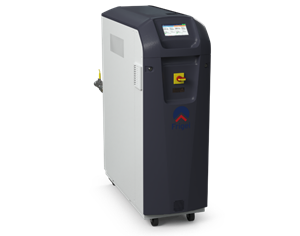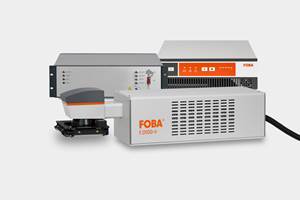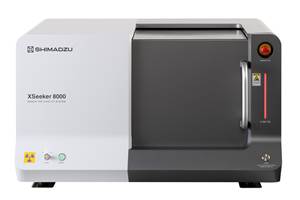Lasers Now Clean Molds and Parts
They drill, cut, weld, polish, engrave, and print.
They drill, cut, weld, polish, engrave, and print. Now here’s something else you can do with lasers—clean molds and parts. Adapt Laser Systems (ALS) applies lasers to non-contact, non-destructive cleaning of injection, compression, and blow molding tools. In addition, lasers can strip contaminants from surfaces of parts to prepare them for decorating or bonding.
ALS is exclusive distributor in North America of laser cleaning systems made by Clean Laser Systems in Aachen, Germany. The equipment comes in 120-W and 500-W versions, each configurable as a portable system or a stationary system for automated production lines. The format most frequently used by processors is a 120-W, stationary system priced at about $125,000, reports Georg Heidelmann, president of ALS.
"Laser cleaning is a precise, cost-effective method for cleaning metal tools when traditional methods fall short," Heidelmann declares, referring to mechanical abrasion, chemical purging, and CO2 ablation. Cleaning lasers are adept at removing additives, colorants, grease, rust, and other contaminants from tool surfaces, while also minimizing abrasion and heat build-up.
ALS’s equipment directs a programmable scanning beam of up to 0.02 in. diam. from a Nd:YAG pulsed, solid-state laser. The metal tool surface reflects laser energy and is minimally affected by it. However, the contaminants on the tool surface absorb the laser energy and are quickly vaporized. Cleaning speed is proportional to the contaminant’s ability to absorb laser energy. Any fumes or particulates are removed by a filter built into the equipment.
Cleaning stops once the contaminant is consumed, and heat build-up is modest. This method reportedly avoids the microscopic roughening and cracking of metal surfaces that sometimes occurs with traditional cleaning methods, thus extending tool life.
Heidelmann says molds can be cleaned in place, without disassembly or removal, when either cool or hot. That means minimal disruption of production schedules and less downtime. Low energy use and lack of consumables keep costs low. Laser cleaning is said to be ideal for applications where molds need frequent cleaning or when mold geometry restricts access to hidden areas. However, lasers need "line-of-sight" access to areas being cleaned, and the color and chemistry of contaminants can affect their ability to absorb energy.
Practical uses surface
Around 50 Clean Laser Systems machines are currently in commercial use, mostly in Europe. Several are used by plastics processors to clean tools or prepare part surfaces. One system is employed in cleaning high-cavitation tools for small electronic parts in which the intricate cavities are hard to reach.
Other applications involve laser treatment of part surfaces to facilitate adhesion. An example is seating for the new BMW 3 series vehicles. Laser cleaning removes residual mold release from the polyurethane parts, ensuring good bonding when the parts are joined to others in seating assemblies.
In another instance, a laser cleaning system is used to roughen the surface of bonding points on a PC part where adhesion strength is critical.
Laser cleaning is also used to replace costly masking steps—e.g., in a nickel-coated housing for a consumer electronic device. In this case, the part is uniformly nickel plated and then the laser removes the nickel from specific areas, making those areas more receptive to decorative chrome plating.
Laser cleaning is also used in continuous, high-speed removal of a protective film from metal edging profiles that require protection. Laser energy passes through the clear protective film and melts the adhesive underneath. The result is high-speed separation of film from the profile.
Related Content
Eco-Sustainable Pad Printing Ink
Incups GN Series passes the ISO cytoxicity test and complies with EuPIA.
Read MorePress-Side TCUs and Full-Plant Adiabatic Coolers
NPE2024: Frigel North America will launch RSY Syncro and RS/MD series, as well as new innovations in at-the-press and whole plant cooling.
Read MoreUltrashort Pulse Laser Marking System for Medical Devices and More
FOBA’s F.0100-ir creates deep black markings on medical plastics, stainless steel and titanium.
Read MoreX-Ray Vision Inside Parts Gets More Affordable for Processors
Shimadzu’s new benchtop x-ray CT scanner provides internal and external metrology and flaw detection at a fraction of the previous cost.
Read MoreRead Next
Lead the Conversation, Change the Conversation
Coverage of single-use plastics can be both misleading and demoralizing. Here are 10 tips for changing the perception of the plastics industry at your company and in your community.
Read MorePeople 4.0 – How to Get Buy-In from Your Staff for Industry 4.0 Systems
Implementing a production monitoring system as the foundation of a ‘smart factory’ is about integrating people with new technology as much as it is about integrating machines and computers. Here are tips from a company that has gone through the process.
Read MoreAdvanced Recycling: Beyond Pyrolysis
Consumer-product brand owners increasingly see advanced chemical recycling as a necessary complement to mechanical recycling if they are to meet ambitious goals for a circular economy in the next decade. Dozens of technology providers are developing new technologies to overcome the limitations of existing pyrolysis methods and to commercialize various alternative approaches to chemical recycling of plastics.
Read More

























